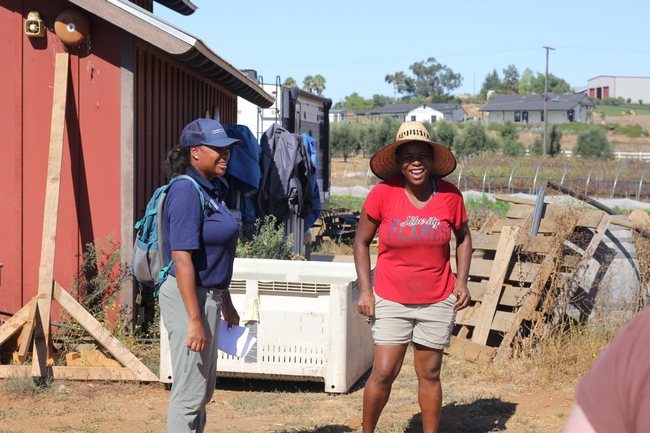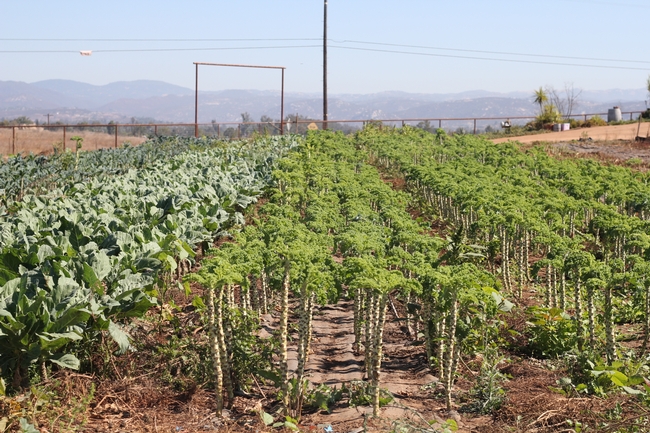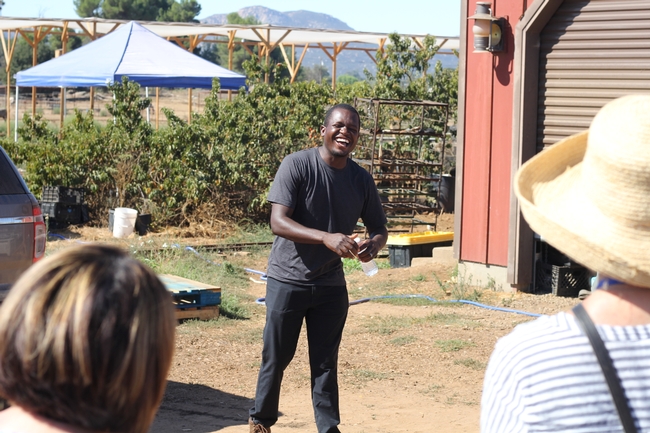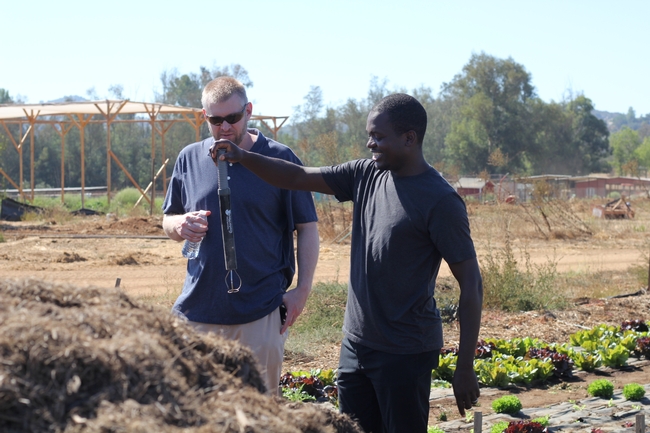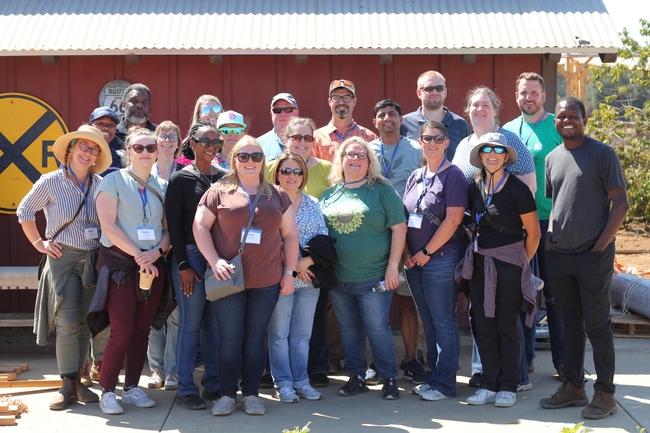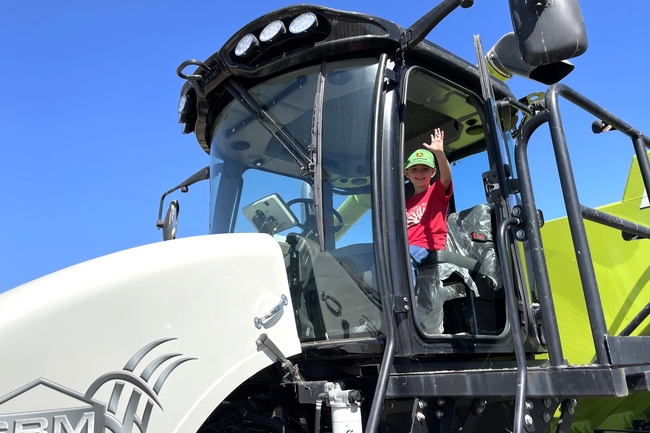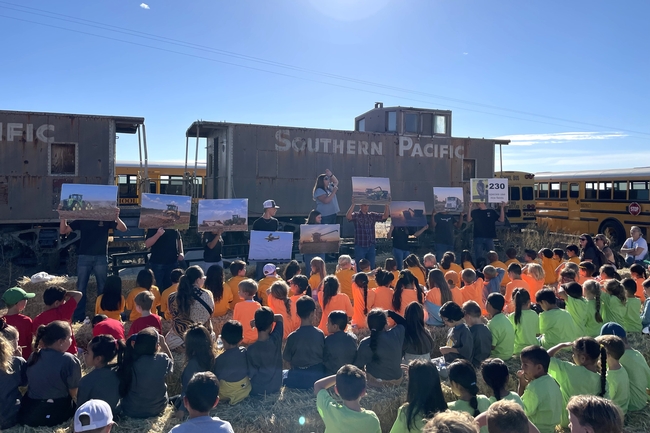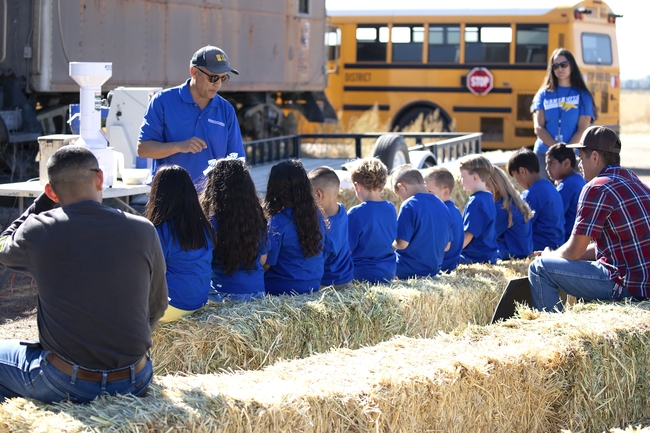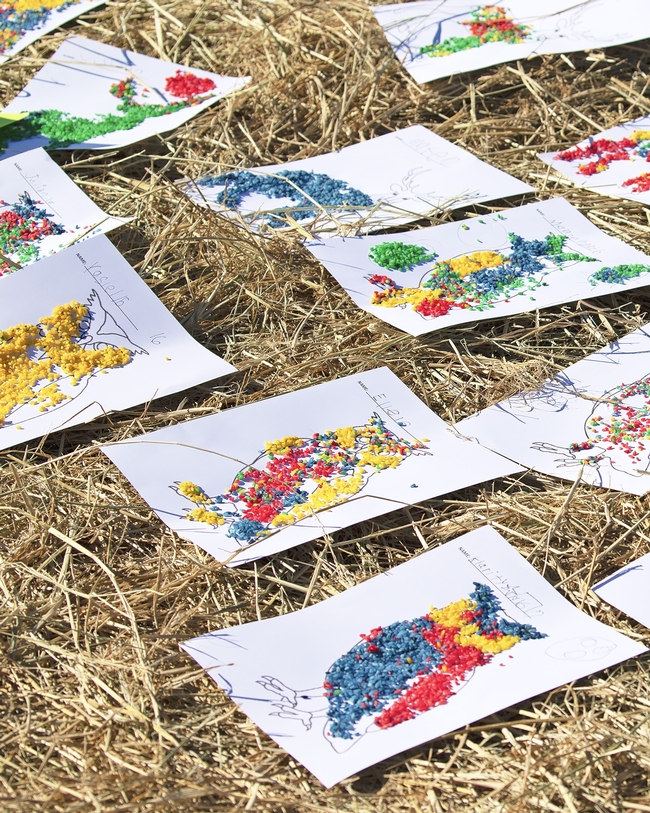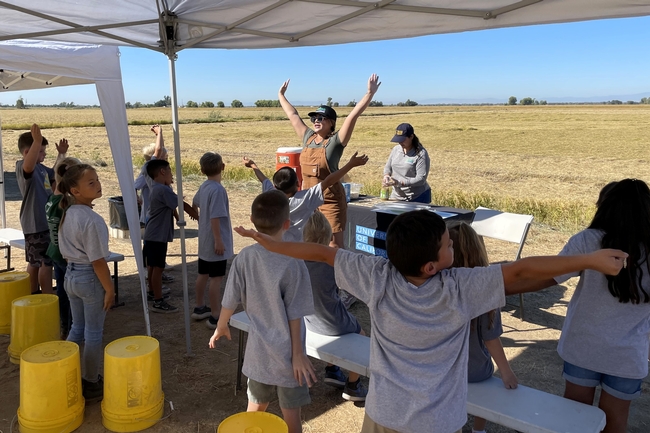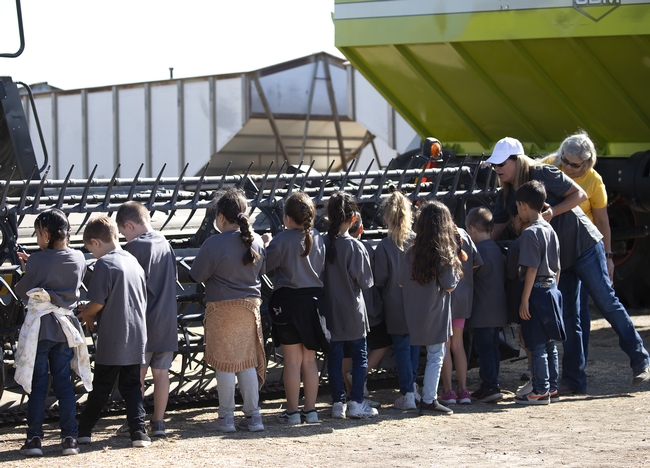
Posts Tagged: food
Students design high-tech solutions through Farm Robotics Challenge
Award-winning teams announced at FIRA USA robotics conference
A robot that navigates and weeds row-crop fields – and its design team from Olin College of Engineering in Massachusetts – have garnered the grand prize in the second annual Farm Robotics Challenge. Five winning teams, representing various universities and colleges across the U.S., were announced on Oct. 24 during a ceremony at the FIRA USA robotics conference in Woodland (watch recording).
A total of nine teams competed in the Farm Robotics Challenge, organized by University of California Agriculture and Natural Resources and the AI Institute for Next Generation Food Systems (AIFS), with support from technology partner farm-ng.
During the yearlong contest, the students engaged with growers about their pain points and challenges and then developed creative solutions using the farm-ng Amiga robot platform.
“It's inspiring to see the creativity and dedication of these students, who put in a lot of hard work and long hours to pull together some truly remarkable projects for this competition,” said Gabriel Youtsey, chief innovation officer at UC ANR. “We hope the challenge attracts more students to consider careers in agriculture; we're here to help build a supportive community to grow that pipeline to the workforce.”
Providing a platform for students to demonstrate innovative design, field testing and evaluation, and real-world problem solving, the Farm Robotics Challenge is sponsored by F3 Innovate, Beck's Hybrids, California Tomato Research Institute and the United Soybean Board.
“It's a great day when engineers, marketing and technology folks understand there are great opportunities to create products for American farmers,” said Brad Fruth, director of innovation at Beck's Hybrids. “It has been exciting for Beck's Hybrids to participate in this challenge and see the bleeding edge of where technology and agriculture converge.”
The student teams leveraged AI, machine learning, automation, coding and fabrication to advance innovation in agriculture.
“Not only does the challenge demonstrate the future of farming with robotics, but it's also encouraging the next generation of engineers to focus their talents on the challenges that exist in growing our food,” said Brendan Dowdle, CEO of farm-ng. “The students who participate have a unique mix of skills in robotics, software and a passion for the future of agriculture.”
Grand Prize Winner: PhoenixBot, Olin College of Engineering, an autonomous mechanical weeding systembuilt to navigate through row-based crop fields of seedling to early-stage crops to effectively remove weeds from the beds
Team Advisor: Kenechukwu Mbanisi
Students:
Summer Crew/Leads: Jeffrey Woodyard, Dokyun Kim, AJ Evans, Toby Mallon, Brooke Moss
Subteam Leads: Dexter Friis-Hecht, Joe Leedy, Maya Adelman, Dominic Salmieri, Chang Jun Park, Akshat Jain
Team Members: Bill Le, Dongim Lee, Felix Halaska, Bhargavi Deshpande, Elisa Camacho, Cooper Penkava, Marcellus Smith, Rohan Bendapudi, Darian Jiminez, Ivy Mahncke, Quinn Verrill, Sam Wisnoski, Oscar Bao, Mia Chevere, Shauna Sperou
Excellence in Productivity: Florabot, Auburn University, a robot designed to autonomously navigate through nursery plant beds collecting imagery data for plant counting and quality assessment
Team Advisor: Tanzeel Rehman
Students: Hamid Syed, Faraz Ahmad, Mesbahul Maruf, Mohtasim Hadi, Carter Freeman
Excellence in Small Farms Technology: Bin Haulers, Washington State University & Heritage University, a precision agricultural robotic system designed for efficient bin-picking and placement in apple orchards
Team Advisors: Manoj Karkee, Safal Kshetri
Students: Dawood Ahmed, Syed Usama Bin Sabir, Divyanth L.G., Priyanka Upadhyaya, Achyut Paudel, Robert Barragan, Apol Medrano, Osmar Alvarez, Bethany Navaroo, Salvador Ayala
Excellence in Sustainability: TAMU-NCSU Robotics Team, Texas A&M University & North Carolina State University, a multi-modal proximal data collection system utilizing artificial intelligence to generate height maps for semi-structured row crop fields to aid in effective application of post-emergence herbicide
Team Advisors: Steven Brian Mirsky, Chris Reberg-Horton, Muthu Bagavathiannan
Students: Joe Johnson, Matthew Kutugata, Ruthvik Kanumuri, Wesley Hawkes, Jonathan Herrera, Luke Conran, Sebastian Chu
Excellence in Safety: University of California Santa Cruz, an application that allows a user to view the camera, as well as operate the Amiga robot, without a physical connection
Team Advisors: Dejan Milutinovic, Darryl Wong
Students: Katherine Rogacheva, Milos Suvakovic, Oliver Fuchs, Sam Leveau, Mauricio Chavez
In addition to recognition for their efforts, the Grand Prize Winner was awarded $10,000, and the Excellence in Productivity and Small Farms Technology winners won $5,000 each, while the Excellence in Sustainability and Safety winners won $2,500 each.
Other competitors in the challenge included teams from Cal Poly San Luis Obispo, California State University Fresno, Hartnell College and The Pennsylvania State University.
For more information about the Farm Robotics Challenge, including details on how to participate, visit https://farmroboticschallenge.ai.
Partners unveil first on-farm robotics incubators
Opening in Salinas and Merced in 2025, Reservoir Farms will drive ag innovations in automation robotics
The Reservoir, a nonprofit building tech incubators across California, and partners Western Growers Association, University of California Agriculture and Natural Resources, Merced College, Hartnell College and venture capital firm HawkTower have announced the creation of the first-ever on-farm robotics incubators, Reservoir Farms.
Unveiled during a press conference at the FIRA USA 2024 robotics conference in Woodland, Reservoir Farms are set to open in the Central and Salinas Valleys in early 2025. This pioneering initiative significantly shifts how agricultural technology innovates through real-world testing environments, world-class resources and critical industry partnerships.
California agriculture faces critical challenges, including labor availability and cost, import competition, increased regulation, water scarcity, and climate-related challenges, including extreme weather. These challenges have spurred significant advancements in agricultural precision, automation, mechanization, and robotics in recent years.
Despite advancements, early-stage agtech projects lack critical ecosystem support, like connecting directly with growers, testing and validating their solutions, and accessing dedicated shop space and farmland. These gaps hinder capital efficiency and the development of critical solutions that meet the agricultural sector's needs.
Initial projects at the incubators will focus on early-stage agricultural innovations in automation and robotics, including rovers and drones, that accelerate the development of breakthrough solutions to the opportunities and imperatives faced by California farms producing high-value specialty crops, such as labor shortages, profitability, and adopting climate-smart technologies.
Western Growers Association, a key advocate for advancing agricultural innovation, will provide financial and operational support as an anchor partner.
Anchor educational partners like UC ANR, Hartnell College, and Merced College will play a crucial role in innovation and workforce development, preparing the next generation of agricultural researchers, professionals, and innovators to drive the future of farming in California.
HawkTower, a venture capital firm investing in early-stage startups developing breakthrough innovations for California's environmental and industrial imperatives, is also an anchor partner.
“The launch of Reservoir Farms is a critical step forward in ensuring the future resilience of California's agriculture and across the Central Coast and Central Valley,” said Danny Bernstein, CEO of the Reservoir and managing partner of HawkTower. “By placing incubators directly on the farm, we enable innovators to test, iterate, and scale solutions in real-world conditions as a more immediate path to advance farming communities.”
A new model to incubate agtech innovation
The idea for Reservoir Farms emerged from extensive industry research and consultations with over 50 organizations in the specialty crop sector. Key insights uncovered critical gaps in startups' access to real-world testing environments, shop space, and direct relationships with growers – factors severely hindered capital efficiency and posed a formidable barrier to innovation.
“Our goal is to eliminate the friction points that have historically slowed down the development of new agtech solutions,” said Walt Duflock, senior vice president of innovation at Western Growers Association. “Reservoir Farms offers a new model, where startups can work side-by-side with growers to test their technologies, iterate in a low-stakes environment, and build scalable solutions to improve agriculture's operations.”
Initiative to support thriving agtech ecosystem and job creation
The Reservoir Farms initiative also reflects a broad-based collaboration between key educational institutions, industry players, and local communities to ensure the next generation of agricultural professionals is equipped with the skills needed to support the region's growing agtech sector.
Supporting partners include Central Coast Small Business Development Center (SBDC), Communities Organized for Relational Power in Action (COPA), Digital NEST, Farmhand Ventures, Merced County Farm Bureau, Milano Technical Group, Monterey Bay DART (Drone Automation & Robotics Technology), Monterey Bay Economic Partnership, Monterey County Farm Bureau, Tesserakt Ventures, and The VINE.
“As robotics and automation become more integral to California agriculture, it's essential to have facilities like Reservoir Farms embedded within the farming community,” said Gabriel Youtsey, chief innovation officer at UC ANR. “By bridging the gap between lab-based research and real-world application and accelerating tech transfer, Reservoir Farms can help build the workforce and technology needed to address the critical challenges on the farm, from labor shortages to climate change.”
Focus on specialized services and real-world testing in California's agricultural heartland
Reservoir Farms will open its first two locations in Salinas Valley and Merced in the first quarter of 2025. Participants can lease testing fields and shop space without the burden of multi-year leases, giving them the flexibility needed to scale. The incubators will offer fully equipped R&D workshops, secure storage for expensive equipment, and customized, pre-planted specialty crop fields for testing.
These facilities will be complemented by Reservoir Farms' co-working spaces, meeting rooms, and a robust demo day schedule designed to connect startups with growers, investors, and other key stakeholders.
In addition, the Western Growers Association's validation process will provide startups with a quantitative “scorecard” that offers crucial metrics on scalability, efficacy, and financial viability. This validation, combined with UC ANR's field testing, will help startups refine their products and receive a critical stamp of approval that builds trust with growers and ensures a smoother path to commercialization.
Media Contact:
Jennifer Goldston
AgTech PR for the Reservoir
816-260-0040
jennifer@agtechpr.com
UC ANR project to help underserved farmers in SoCal with land ownership
San Diego County has more than 5,000 small farms but less than 2% are operated or owned by Black, indigenous, or people of color – including those of Asian, Hispanic or Native Hawaiian/Pacific Islander descent, according to the 2022 Ag Census.
The reasons vary, but historically, multiple marginalized communities of color have not received the same opportunities or support for land ownership or management as their white counterparts.
Chandra Richards, University of California Cooperative Extension land equity academic coordinator for the Southern California region, is identifying barriers to equity when it comes to addressing land access, tenure, management and opportunities to increase the diversity of land managers and land ownership in the region.
Richards is the principal investigator for the Climate Action and Land Equity (CALE) project administered through UC Agriculture and Natural Resources and funded by the Department of Conservation. CALE aims to engage historically underrepresented communities in coalition building, capacity assessment and climate action planning. CALE elevates knowledge about the challenges and opportunities to land access and management for a diversity of land managers.
Among the challenges is land tenure, an established agreement between a landowner and tenant, outlining the purpose and use of the land over a period of time. However, when landowners decide to sell their land, these agreements are at risk of being null and void, forcing the tenants to renegotiate or discontinue their operation.
Land tenure leases for under five years are considered short-term, which are common in Southern California. For small, new and under-resourced farmers, landowner turnover doesn't just threaten their business plan but their livelihood.
For small farmer Byron Nkhoma, who leases land in Ramona to grow leafy greens and vegetables, the possibility of losing land is a constant worry. Since 2015, Nkhoma and his wife, Joyce, have been renting four of 20 acres to establish Hukama Produce. Over nine years, they have had two landowners. Before the land was sold to his current landowner, Nkhoma said he considered buying land, but the process proved more challenging than he thought.
“What it takes for someone like Byron to find a place to farm and establish a food system is an extremely involved process,” said Richards. “It's not just learning how to obtain land, it's also about managing that land so it can be used for years and generations to come.”
Originally from Zimbabwe, Nkhoma is adamant about taking care of the land he leases and has applied knowledge from his home to ensure resilience. Hukama Produce prides itself in improving environmental health through sustainable farming practices such as compost and mulch application, drip irrigation and low till. An important pillar of the CALE project includes building capacity and providing technical assistance toward land conservation and climate resiliency.
In addition to land tenure, money and time are stressors for small farmers. When they are not working on the farm, Nkhoma and his wife are researching and applying for grants to improve their soils and protect their crops from pests. However, many grants for which Hukama Produce is eligible often have pressing deadlines that demand their immediate attention – cutting into valuable time that could be spent tending to the land or selling at farmer's markets.
Two of Hukama's goals include building and sustaining trust in the market and growing their operation. By partnering with Richards, Hukama Produce has direct access to technical assistance focused on grant writing and conservation to increase ecosystem health and build tenure.
Agricultural land tenure is the arrangement, rights, and responsibilities centered around use, management, and ownership of agricultural land and resources. Building land tenure means that farmers have a stable place to grow their crops and build environmental sustainability without risk of having to move their operations.
While the CALE project boosts support for historically underserved community members hoping to own or manage land, it prioritizes land use for food production as a reinvestment into the greater community.
Eager to bring realities like Nhkoma's to light, Richards partnered with Keith Nathaniel, UCCE director for Los Angeles County, who co-coordinated the Western Extension Leadership Development conference held in San Diego the week of Sept. 23-27. WELD unites Cooperative Extension faculty, agents, advisors, educators and specialists from the western region of the United States for a two-year leadership development program.
While in San Diego, WELD participants joined Richards for a tour of Hukama Produce and learned directly from Nkhoma about opportunities and threats as a small farmer. The tour ended with participants in a circle, sharing how their professional roles can offer support to Hukama Produce and other small farms.
“We grow food so that we can feed the community,” said Nkhoma. “When we feed others, we build relationships. That's what ‘hukama' means – to grow relationships.”
If you operate or know of a small farm in Southern California and would like to be involved with or receive regular updates about the CALE project, please contact Chandra Richards at cmrichards@ucanr.edu.
If you are interested in applying for the Land Equity Project Manager position, please visit https://ucanr.edu/About/Jobs/?jobnum=2894 for details.
Welcome GrizzlyCorps Fellow: Brenda Rodriguez Meza
Hi! My name is Brenda (She/Her) and I am a GrizzlyCorps Rural Climate Fellow at The Hopland Research and Extension Center. Let me tell you a little bit about myself and my interests. I grew up in Goleta, CA and from a young age, found myself gravitating to community gardens. At these urban community gardens, I discovered the importance of capacity building and mutual aid through different partnering organizations. Some of my interests include ethnobotany, photography, and multi-media collage making. I enjoy exploring various decolonial ecological theories which have helped me (re)discover and (re)define my relationship to land, institutions, and allow me to explore embodied knowing. While studying at UC Santa Cruz I concentrated my work on Global Environmental Justice and spent a lot of time familiarizing myself with the Chadwick Garden and the CAFS Farm and garden through different fieldwork. On these sites, I studied pollinators, agroforestry, and rotational crop systems. Through my studies I came to recognize the necessity for localized food systems and climate-stabilizing food production that would tackle the issue of excessive food waste. I have recently enjoyed learning about food sovereignty movements like the one led by Ghanaian agroecologist, Vandana Shiva. Her work in seed saving has been incredibly admirable as it is the basis for the stability of ecological systems. Shiva's initiative titled Navdanya began after the green revolution and has since been able to establish seed banks in various communities in India and Bhutan. The Navdanya program catalyzed the initiative to mainly liberate farmers from relying on commercial seeds. The Seeds of Vandana Shiva is a great documentary if you are interested in Indigenous seed-saving systems and the battle many farmers fought against Bayer Monsanto to generate resiliency for their communities.
Here's a link to it!
https://archive.org/details/the-seeds-of-vandana-shiva-2021-720x-480-16x-9

Brenda Rodriguez Headshot
Butte County first graders enjoy ‘ricetastic’ day at local farm
UC Cooperative Extension advisors, educators join growers in showcasing rice production
When Tracy Schohr volunteered in her son's pre-K class a couple years ago, she was stunned to find out that only two of the 20 children had ever been around a tractor. And this was in the rural Butte County community of Gridley, in the heart of California's rice-growing region.
Seeking to introduce more young children to agriculture, Schohr – the University of California Cooperative Extension livestock and natural resources advisor for the area – and her friend Lisa Donati created an event to showcase rice farming.
After the debut of “Ricetastic Day” last year with about 140 students from Gridley in attendance, this year's event on Sept. 19 attracted more than 240 schoolchildren – this time from across south Butte County.
First graders from McKinley Primary School in Gridley, Manzanita Elementary School, Biggs Elementary School and Richvale Elementary School – along with their teachers and many family members – enjoyed hands-on experiences at Schohr's rice and cattle ranch.
“There's a dwindling population that produces the food that we eat across America, so how can we have more people know, appreciate and love agriculture if we don't give them that opportunity?” said Schohr. “That's what this day is really about – to teach them about rice, to teach them about their community, how healthy rice can be, and how the farming and ranching can also create habitat for wildlife. It's all-encompassing.”
Event stations share different aspects of rice
Schohr, who grew up on the family ranch in Gridley, remembers coming with her McKinley schoolmates for a visit. But those field trips had comprised only lunch and a quick “drive-through” tour of the historic farming operation.
For Ricetastic Day, however, Schohr organized – with generous help from local growers and community partners – a more comprehensive half-day of activities. After her brother, Ryan Schohr, welcomed the participants to the family farm, the students formed groups that were led by Gridley FFA youth on a rotation through a variety of stations.
At the milling station, Luis Espino, UCCE rice farming systems advisor, demonstrated how his mini mill machines remove the husks from rough rice to make brown rice, and then polish away the bran layer to make white rice. He had the children see and feel the difference as the rice moved through processing.
“I didn't even know brown rice existed!” exclaimed Elsie, a first grader at McKinley.
A native of Peru, Espino came to study agriculture through his lifelong fascination with biology and living things – and he said events like Ricetastic Day can inspire a similar passion in young people.
“It might spark their curiosity so that they might go into these areas of work in the future or have a career in agriculture, when they see that people do this for a living,” Espino said.
Ray Stogsdill, another McKinley school alumnus, returned to Gridley after college to pursue just such a career. A staff research associate in the lab of UC Davis professor Bruce Linquist, Stogsdill manages on-farm rice variety testing across the region. He volunteered to help Schohr with Ricetastic Day by talking about some of the heavy equipment and providing his perspective for the kids.
“They drive by the fields and they don't know what's out there,” he said. “This gives them a chance to know what they're driving by, so they can say, ‘We have rice here and this is how it works; this is how it grows.' It gives them an idea of what's going on around them.”
Where rice fits within a healthy diet was the focus for the CalFresh Healthy Living, UC Cooperative Extension team, comprising nutrition educators Sunshine Hawjj, Joanna Aguilar and Kenia Estrada, as well as community nutrition, health and food security advisor Veronica VanCleave-Hunt. They talked about how rice – like other grains in that vital food group – gives people energy, and then taught the students an energetic “ricetastic” movement activity.
“Because our program is part of UC Agriculture and Natural Resources, it's important to make the connection between where our food comes from and how it gets on our plate – especially with young kids, so that we can promote value for our local agriculture and our food systems,” VanCleave-Hunt explained.
Activities spark further conversations, learning about agriculture
With rice harvest late due to late planting in the spring, Eric Waterbury of Waterbury Farms was able to take some time to attend the event. Although his family has been growing rice for three generations, he said he appreciates opportunities for the broader community to see all aspects of his work – from the equipment to the processing.
“If the kids walk away from this with one thing, I hope it's that they realize every time they have a meal, somebody was out there working hard to provide that meal,” he said. “It wasn't just the person at the grocery store that provided it for them.”
Schohr added that Ricetastic Day was only possible through the support of the community. Butte County Farm Bureau and Natural Resources Conservation Service staff helped kids make art with colorful dyed rice; neighboring farmer Tinker Storm described how the harvester and “bankout” wagon work; and rice farmers Shelley Beck and Sue Orme read aloud “Daddy's Got Dirt: A California Rice Story,” a children's book written by a local rice grower.
With rice at the center of physical activities, arts and crafts, and science lessons for the day, the students learned a lot to take home.
“It's nice that the kids got these hands-on learning experiences,” said Ryan Schohr, “so they can go home tonight and, at the dinner table, talk about it with their parents or brothers and sisters, over dinner or over homework – and share what they learned here on the farm and about their community.”
Rebecca Christy, a first- and second-grade teacher at Biggs Elementary, said she is excited to return to the classroom and hear from her students about all that they learned during the day.
“Every morning right now I'm seeing the big trucks going by our school, and so I'll be able to point that out to them, ‘Where are they going? What are they doing?'” she said. “I can't wait to get back to school and let them tell me about all of this.”
One of her students, Ximena, was finishing her brownbag lunch as the group watched one of the Schohr Ranch harvesters rumble over the field. Despite enjoying a rice cake and a rice cracker earlier, she said her meal was missing one thing.
“Where is my rice, Miss Christy?” she said. “I want rice!”









